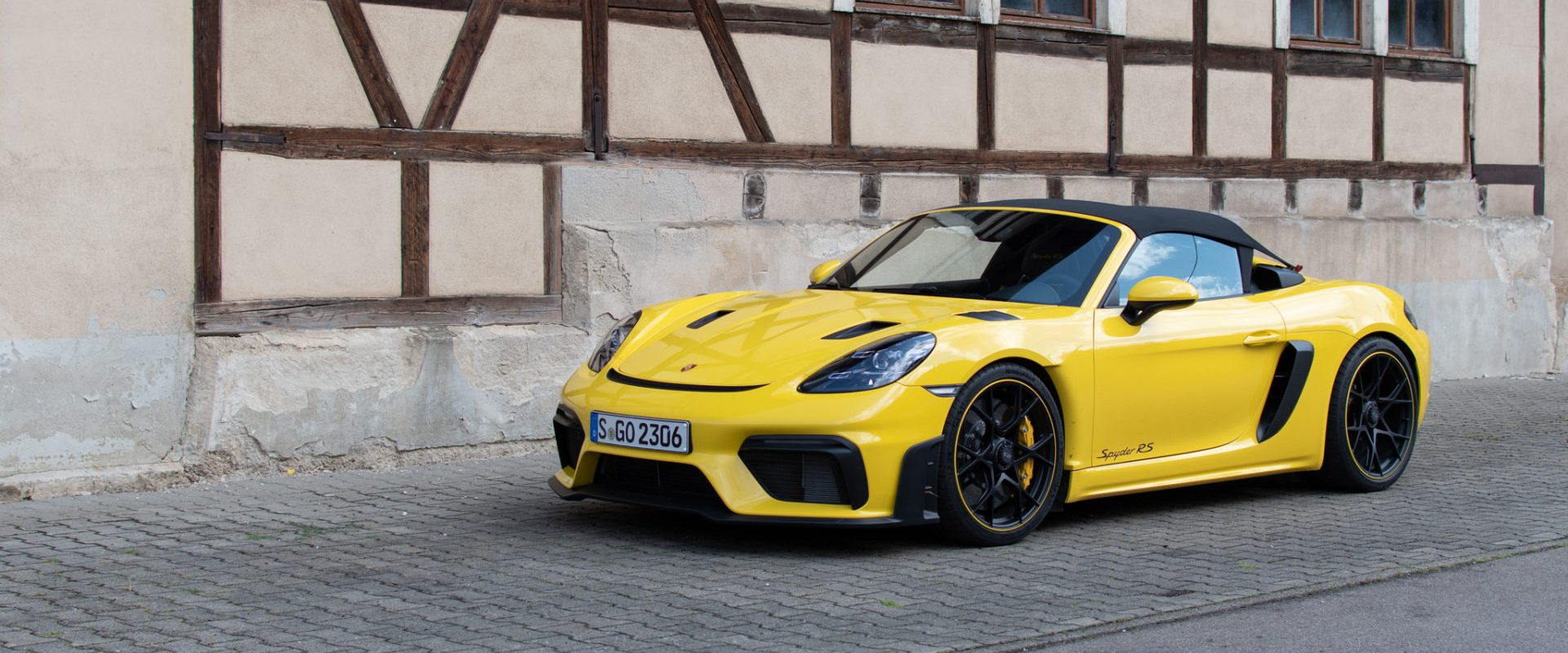2024 Porsche 718 Spyder RS
A Convertible Option for our Favorite 718
When Porsche took the engine out of a 911 GT3 and stuffed it into a 718 Cayman to make the GT4 RS, we called it the “most amazing Cayman ever.” Now they’ve gone ahead and given the GT4 RS a convertible companion, the 718 Spyder RS.
It serves up its own brand of insane fun, now angled more towards the streets than the track. I was invited to Stuttgart, Germany where the winding country roads and varying gradients of the Swabian Alps gave me the perfect landscape to carve in this two-seater roadster.
Of course, with my luck I flew all the way across the Atlantic to drive a convertible and rain was in the forecast, but that didn’t put a damper on our parade of Boxsters.
That’s primarily thanks to the powertrain, as it’s hard not to smile when wringing out this naturally aspirated, 4.0-liter boxer six-cylinder to its 9,000 RPM redline, putting down 493 horsepower and 331 lb-ft of torque in the process.
The Spyder RS boasts a 79 horsepower advantage over the “regular” 718 Spyder, the RS reaching 60 miles-per-hour in 3.2 seconds thanks to the quick-shifting PDK transmission. Speaking of, the seven-speed PDK is standard in the RS.
“I first got to experience this powertrain in the 718 Cayman GT4 RS, a track-focused car that… well, I took to the track. Summit Point Raceway in West Virginia, as a matter of fact. Now, I’m a long way from home on these German roads, but, uh, the powertrain is still very visceral. I mean 4.0-liters, six-cylinder boxer and, of course, it’s mounted midship. You have the intakes right by your ear. It sounds great and it’s a whole lot of fun to drive. But I think the most impressive number here is the 9,000 RPM redline which just… it absolutely screams when you get it up there…
And you get it up there through a seven-speed PDK. That’s an automatic, and I know some purists would like to see a six- or seven-speed manual in this car which… uh, you know, I– I kind of agree with. Uh– you know, if you’re gonna take this out on a Sunday afternoon it’s nice to have, uh, something, you know, “row it yourself.” Uh, but Porsche’s seven-speed PDK is a phenomenal transmission. It’s a lot of fun; and with that RPM, with that power in mind, it’s still just as easy to ‘drop a gear and disappear,’ or, I suppose with this transmission, uh, ‘flap a paddle and skedaddle.’”
The powertrain is just as potent as it is in the GT4 RS, but the suspension and chassis tuning in the Spyder RS is more setup for street use. Spring and damper rates have been reduced, which may slow lap times by tenths of a second, if that, but makes the on-street experience softer and more comfortable. The Spyder RS is a little better at absorbing the road. Still, I wouldn’t quite call it a casual experience, as everything feels quite connected. Steering remained very precise, and the RS is ready for whenever you decide to kick your driving up a notch.
And not if, but when you do, you’ll feel the benefits of the standard-equipped Porsche Active Suspension Management and Porsche Torque Vectoring with a mechanical rear limited slip differential.
And while we’re on the topic of Porsche lingo, the “RS” moniker doesn’t just denote power, but also weight savings and aerodynamics.
The body has been lightened through various applications of carbon fiber reinforced plastic– CFRP for short, used upfront on the hood and wings. The RS also boasts less insulation material, lighter interior carpet and, the defining feature, a lightweight, manually operated top. You could achieve maximum weight savings by leaving the top at home. Just check the forecast first.
Aero elements aren’t as extreme as the GT4 RS, but still very present, like the wheel arch vents, NACA ducts and revised rear diffuser. The GT4 RS’s large rear wing is noticeably absent, replaced now by a small ducktail spoiler.
If this isn’t enough for you– or you just figure “go big or go home”– you could equip the optional Weissach Package, featuring exposed carbon-weave on various parts joined by optional 20-inch magnesium wheels– 10 kilos lighter than the standard aluminum set. Aero is enhanced by a carbon Gurney flap, and inside you’ll find special headrests and an anti-glare Race-tex dash.
Weissach or not, the interior, while performance-focused, is relatively comfortable even with the included full bucket seats. The driver is aided by a semi-digital instrument panel and a large enough infotainment screen. Lots of physical buttons, too, so no diving into menus just to flip on the fans or change the volume.
Then again, get behind the wheel and music will likely rank second to the naturally-aspirated symphony harmonizing behind you, the 4.0-liter boxer-six breathing in right next to your ear. From the killer soundtrack to the way it feels on the road, the Spyder RS is a thrill to drive.
And it really ought to be, considering the price, starting just over $160,000 once stateside deliveries begin in Spring 2024. Our Racing Yellow tester came out to just over $180-grand, with notable options including the Front Axle Lift system and Ceramic Composite Brakes.
The Spyder RS is an excellent companion to the GT4 RS. If you want to hear more about a 911-powered 718, go check out our Track Test of the Cayman GT4 RS. And, as always, drive safe and stay tuned to MotorWeek.






